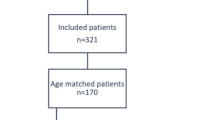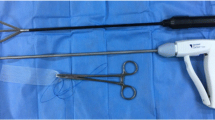Abstract
The aim of the study was to evaluate the short-term success of robotic sacrocolpopexy using the Quill bi-directional polydioxanone (PDO) suture. This was a retrospective observation study of women undergoing robotic sacrocolpopexy performed by a single surgeon between May 2008 and August 2010. Pelvic organ prolapse was determined using the pelvic organ prolapse quantification scale (POP-Q). Baseline exam were performed preoperatively and scheduled at 6 weeks, 3 months, and yearly thereafter. Treatment success defined as a POP-Q measurement of point C that did not descend for more than one-half the total vaginal length and a measurement for point Ba that was less than −1. A total of 36 patients were eligible for enrolment in the study. The mean age was 70 years (range 49–86 years), and mean body mass index was 27 kg/m2 (range 19–41 kg/m2). The mean interval follow-up was 166 days (median 116; range 34–772 days). Anatomic success was 92% (33/36). In the short term, the Quill SRS PDO suture provided sufficient fixation of an Amid type I polypropylene mesh to the vagina to result in excellent anatomic success with only rare complications.




Similar content being viewed by others
References
Maher C, Feiner B, Baessler K et al (2010) Surgical management of pelvic organ prolapse in women. Cochrane Database Syst Rev 4:CD004014
Whitehead WE, Bradley CS, Brown MB et al (2007) Gastrointestinal complications following abdominal sacrocolpopexy for advanced pelvic organ prolapse. Am J Obstet Gynecol 197:78.e1–78.e7
Begley J, Kupferman S, Kuznetsov D et al (2005) Incidence and management of abdominal sacrocolpopexy mesh erosions. Am J Obstet Gynecol 192(6):1956–1962
Ross J, Preston M (2005) Laparoscopic sacrocolpopexy for severe vaginal vault prolapse: five-year outcome. J Minim Invasive Gynecol 12(3):221–226
Greenberg J, Einarsson J (2008) The use of bidirectional barbed suture in laparoscopic myomectomy and total laparoscopic hysterectomy. J Minim Invasive Gynecol 15:621–623
Bump RC, Mattiasson A, Bo K et al (1996) The standardization of terminology of female pelvic organ prolapse and pelvic floor dysfunction. Am J Obstet Gynecol 175:10–17
Ghomi A, Askari R (2010) Use of a bi-directional barbed suture in robot-assisted sacrocolpopexy. J Robotic Surg 4(2):87–89
Culligan P, Murphy M, Blackwell L et al (2002) Long-term success of abdominal sacral colpopexy using synthetic mesh. Am J Obstet Gynecol 187:1473–1480
Barber M, Brubaker L, Nygaard I et al (2009) Defining success after surgery for pelvic organ prolapse. Obstet Gynecol 114(3):600–609
Greenberg J, Clark R (2009) Advances in suture material for obstetric, gynecologic surgery. Rev Obstet Gynecol 2(3):146–158
Lai S, Becker D, Edlich R (2010) Sutures and needles. eMedicine. March 31, 2010. Available at: http://emedicine.medscape.com/article/884838-overview Accessed 1 Oct 2010
Angiotech Pharmaceuticals (2010) Quill SRS instructions for use. Angiotech Pharmaceuticals, Vancouver
Brubaker L, Cundiff G, Fine P et al (2003) A Randomized trial of colpopexy and urinary reduction efforts (CARE): design and methods. Controlled Clin Trials 24:629–642
Shippert R (2005) A study of time-dependent operating room fees and how to save $100,000 by using time saving products. Am J Cosmetic Surg 22(1):25–34
Jandali S, Nelson J, Bergey M, et al (2010) Evaluation of the use of a barbed suture for skin closure during autologous breast reconstruction. J Reconstr Microsurg, doi:10.1055/s-0031-1275491. Available at: http://www.media-mci.info/asps/abstracts/back_%20speakers/005.Shareef_Jandali_Evaluation_Of_The_Use_Of_A_Barbed_Suture_For_Skin_Closure_During_Autologous_Breast_Study.pdf Accessed 1 Oct 2010
Acknowledgments
The author wishes to thank Drs. Lennox Hoyte and Tom Julian for their encouragement and editorial insight. Statistical analysis was performed by Ron Fisher, PhD, at Fisher Statistics.
Conflict of interest
None.
Author information
Authors and Affiliations
Corresponding author
Appendix
Appendix
Introduced in 1996, the Pelvic Organ Prolapse Quantification (POP-Q) system is an objective, site-specific system used for describing and staging pelvic support in women. There are nine points of measure, with six of these points being measured relative to the hymen. Points above the hymen are negative, points below the hymen are positive, and points at the hymen are zero. All measurements are recorded in centimeters. Patients are examined in the supine position with an empty bladder, and except for TVL (total vaginal length), all measurements are taken with the patient performing maximum Valsalva effort.
Point | Description | Range |
|---|---|---|
Aa | Midline anterior vagina 3 cm proximal to the hymen | −3 to +3 cm |
Ba | Most dependent part anterior vagina | −3 cm to + TVL |
C | Cervix or vaginal cuff | + or −TVL |
D | Posterior fornix (N/A if post-hysterectomy) | + or −TVL |
Ap | Midline posterior vagina 3 cm proximal to the hymen | −3 to +3 cm |
Bp | Most dependent part of posterior vagina | −3 cm to +TVL |
GH (genital hiatus) | Distance from middle external urethral meatus to posterior midline hymen | >0 |
PB (perineal body) | Distance from posterior midline hymen to middle of anal opening | >0 |
TVL (total vaginal length) | Greatest depth of vagina when point C or D is reduced to normal position | −3 cm to +TVL |
Stage 0 (no prolapse) | Points Aa, Ap, Ba, Bp all = −3 cm and either point C or D ≤ (TVL −2) cm |
Stage I | Criteria for stage 0 are not met and leading edge of prolapse < −1 cm |
Stage II | Leading edge of prolapse ≥ −1 cm, but ≤ +1 cm |
Stage III | Leading edge of prolapse > +1 cm, but < +(TVL − 2) cm |
Stage IV | Leading edge of prolapse ≥ +(TVL − 2) cm |
Rights and permissions
About this article
Cite this article
Stubbs, J.T. Short-term results of robotic sacrocolpopexy using the Quill SRS bi-directional polydioxanone (PDO) suture. J Robotic Surg 5, 259–265 (2011). https://doi.org/10.1007/s11701-011-0267-6
Received:
Accepted:
Published:
Issue Date:
DOI: https://doi.org/10.1007/s11701-011-0267-6




